► Family crossover Giant Test review
► Peugeot 408 vs Cupra Formentor vs Kia EV6
► Petrol, hybrid or full electric?
Family car buyers have never faced more bewildering choice. Take the new mainstream crossover sector: not quite SUVs, nor are they hatchbacks – and they’re available in a head-spinning array of powertrains, with petrol, diesel, hybrid and electric all available.
Here we take three of the latest genre-bending crossovers: the petrol Peugeot 408, which takes on the pure electric Kia EV6 and the stepping-stone plug-in hybrid Cupra Formentor. Read our comparison test to see which best hits the brief.
Want to get all the intel first, and access more amazing content from CAR? Become a member of CAR VIP here with a 99p trial!
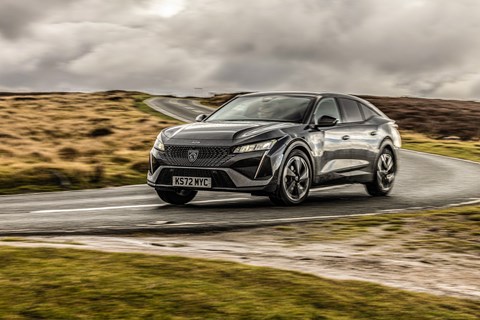
Pre-flight briefing: Peugeot 408
Why is it here? Another attempt to reinvent and add spice to the SUV/crossover, the Peugeot 408 is long, low and lithe – at least by SUV standards. It’s intended to look new while ticking the traditional Peugeot boxes – roomy, comfortable riding, good to drive, and practical. Peugeot claims it’s a new type of car. Think of it as part sports estate and part SUV, and you get the picture.
Any clever stuff? The stand-out novelty is the head-turning style and its unusual dimensions: stretched bonnet and long flowing fastback tail. Tech includes Peugeot’s familiar i-Cockpit, with a clear and intuitive 10-inch touchscreen and small steering wheel, for added agility. There’s also adaptive cruise control, night vision – warning of animals, pedestrians or cyclists – and long-range (75-metre) blind spot monitoring.
Which version is this? We could have chosen one of two plug-in hybrid units, but we’ve plumped for the nicest-to-drive 408: the conventional turbo petrol-powered 1.2L, in mid-range Allure Premium spec. It’s also the best-value 408. If company car tax is important, the plug-in hybrids – with their unrealistically high official mpg figures and unrealistically low official CO2 figures – might make financial sense.
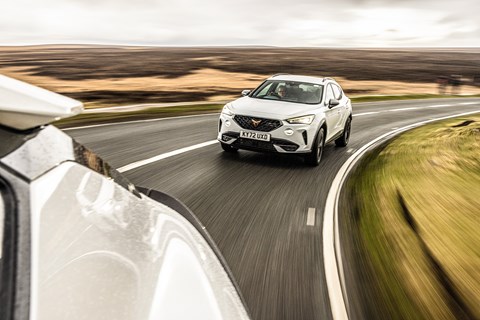
Why is it here? The Peugeot may straddle car segments, but the nearest conventional class is the SUV coupe, where one of the very best is the Cupra Formentor. Like many current Cupras, the Formentor offers a surprisingly engaging drive. Performance is good too, especially in the top-end 242bhp hybrid (as tested) and 306bhp 2.0-litre petrol versions.
Any clever stuff? In keeping with its sports character, the Formentor has a twin-clutch DSG gearbox rather than a conventional automatic. It’s a well spec’d car and includes adjustable dampers ranging from Comfort to hardcore Cupra – which also artificially pipes in, via the speakers, exhaust howl from a five-cylinder engine. The voice control of the operating system is woken up by hollering ‘hola, hola’. It may help improve your Spanish but, as with most voice systems, it’s a bit hit and miss.
Which version is this? There’s a big range of Formentors, from 1.5-litre TSI (sweet to drive, if not terribly fast), to max-attack 306bhp four-wheel-drive 2.0 turbo. We’ve chosen the sportiest plug-hybrid, the e-Hybrid 245, in upper-spec VZ2 guise. It uses the familiar 1.4 VW group petrol engine, and supplementary electric motor, for a combined power output of 242bhp.

Pre-flight briefing: Kia EV6
Why is it here? It may not think of itself as an SUV coupe, but the proportions of the Kia EV6 are very similar to both the Formentor and, even more so, the 408. It’s also sportier than its platform-sharing Hyundai Ioniq 5 sister car – firmer of suspension and sharper to steer. Plus, like its rivals here, the EV6 is a striking looking car, and lower than the crossover norm.
Any clever stuff? The EV6 is one of the most advanced electric cars on sale, and one of our favourite EVs. Of special note is its 800-volt architecture, a technology also found on the Porsche Taycan. The advantages are manifold, from faster charging to lighter cabling and less heat build-up. Using a 350kW charger, you boost the 77.4kWh battery from 10 to 80 per cent in just 18 minutes – usefully quicker than most.
Which version is this? It’s the basic rear-drive Air version, our favourite EV6. It handles more sweetly, with more rear-drive bias, than the pricier and posher all-wheel-drive GT-Line models. There’s less power – 226bhp versus 321 for the twin-motor version. Performance, however, is perfectly adequate – 0-62mph in 7.3sec. The upside is a longer range – 328 miles (the official combined figure) is one of the best in class.
The SUV just keeps on evolving and multiplying. We now have SUV coupes (never mind they invariably have four doors, not two); we have SUV fastbacks (more or less a big hatchback on stilts); there are luxury SUVs; and there’s the increasingly popular sports SUV (a tautology as well as an oxymoron: utility vehicles may be brutishly fast but they can never be sporty). Plus, there are endless crossovers – SUVs that looks less like armoured personnel carriers and more inflated hatchbacks, with just a hint of 4×4 tough-guy padding.
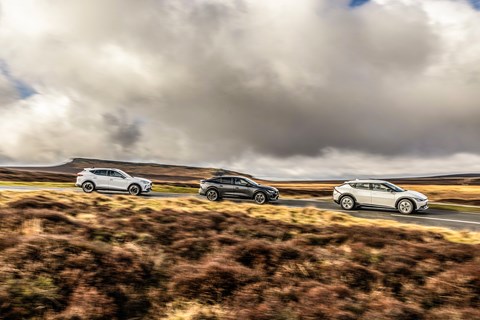
And now we have a new Peugeot 408 that, says its maker, is a ‘new breed of car’. In as much as it can be pigeonholed at all, it is an SUV/estate/crossover/hatchback/coupe/fastback. In essence, it’s a low-roofed SUV with the styling swagger of a sports estate. Its design has more in common with a sports Jaguar than an SUV Jeep.
It’s also unusually lengthy of bonnet and long of tail, to highlight its streamlined style. Yet it has SUV space, SUV body armour and elevated ground clearance – but not the commanding second-storey view afforded by most big SUVs.
So it’s a bit of an outlier. It doesn’t even have Peugeot’s traditional ‘double 0’ SUV nomenclature. Yet if we look around our big and disparate car market, it’s not hard to find like-minded rivals – such as Cupra’s ‘SUV coupe’ Formentor.
The Formentor is Cupra’s first stand-alone model (as opposed to a tarted-up Seat). Many people will have no more idea about the Formentor name than they do about Cupra. But the hardcore cyclist in me knows it’s a peninsula and tough climb in northern Majorca (I’ve cycled up it, to the historic lighthouse at the tip of the peninsula). As an SUV coupe, the Cupra Formentor is lower and more stylish than your average 4×4, and most iterations – including our test car’s plug-in hybrid powertrain – offer better than average performance, too.
Our final protagonist makes no claims to being an SUV. Rather, the Kia EV6 is an electric crossover, a recent Giant Test winner (against Ford Mustang Mach-E and Volkswagen ID. 4) and one of our favourite EVs. Its dimensions are very similar to the 408’s – almost identical length and width, albeit with much shorter overhangs – and it’s just a few inches higher.
Like the Peugeot, the EV6 is a striking looking car: if Kia tagged it an electric fastback SUV, few would demur. Its price, as tested, is very similar to the Cupra’s, and its performance – 0-62mph in 7.3sec – is almost identical.
What gives this confrontation some added spice is that the three protagonists use different powertrains. The 408 is available with two different PHEV units, and a conventional 1.2-litre petrol. An electric version comes next year. We’ve chosen the 1.2. It may be the least powerful 408 and the slowest on paper. But experience has shown it’s the most fun to drive and the Allure Premium version comes with a very decent spec.
The Formentor is also available as a non-hybrid, front-drive model, and the normal 1.5-litre TSI 150 is one of our favourite versions. Today, we’ve plumped for the top-spec e-Hybrid, the 245. Its 1.4 petrol engine and supplementary e-motor have a combined output of 242bhp. The Cupra brand prioritises performance and sportiness, and if you want a Formentor plug-in hybrid, then it gets no faster or sportier than this: 0-62mph is covered in 7.0 seconds.
So it’s combustion engine versus PHEV versus EV, as well as Peugeot versus Cupra versus Kia, and fastback SUV versus coupe SUV versus crossover.
We start in the Peugeot. It’s a head-turner, from its distinctive bluff Peugeot nose complete with ‘fang shaped’ (Peugeot’s words) front light signature to its ‘three clawed’ (and again) rear lights. Peugeot even refers to the aero appendages at the top of the rear pillars as ‘cat’s ears’. (You can see the feline styling theme.) It’s long and streamlined but fussy around the rear. Handsome? Not to my eyes. It tries just a bit too hard to be contrarian, but at least it looks different.
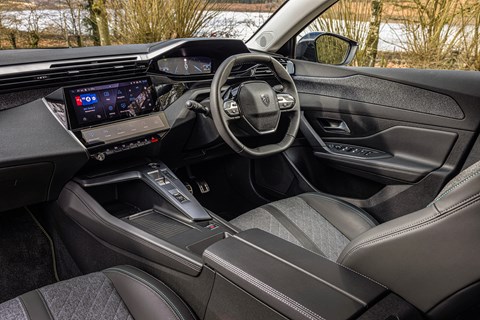
Inside it is largely familiar to anyone acquainted with the 308 hatch – and that’s no bad thing. The dashboard is the same: angular, sharp edged, nicely finished and furnished, and complete with a handsome and easy-to-use 10-inch centre touchscreen. There’s Peugeot’s small steering wheel, over which the instruments peek. The upside is sharper and more alert steering. The downside is partially sighted instrumentation. It’s a big car and feels it. The rear seems to end a long way back and visibility behind you isn’t good. At least there’s a rear parking camera.
The 1.2 triple doesn’t deliver sparkling performance – 0-62mph in 10.4sec is easily the slowest figure here. Yet it’s perfectly adequate and as long as you don’t mind rowing through the gears and revving the tuneful little engine, it can motor along nicely.
Our meeting point is the Peak District, one of England’s famed beauty spots, and great for driving. It was England’s first national park, 555 square miles of brown-and-green patchwork uplands, crisscrossed by some of this island’s best driving roads. Manchester, Derby and Sheffield are all close, but our Grand Day Out is on a Monday in late winter, and the hope is that the tourists from nearby cities will stay away. Apart from some ramblers and cyclists, they do.
The Peak District – famous as a setting for Pride and Prejudice, Last of the Summer Wine and Wordsworth poetry – is about four hours and 200 miles north of London, so the evening before our early- morning rendezvous I drive up the M1, destination the Huntsman Inn just outside Holmfirth. On the M1, the 408 impresses with its easy-going gait, its comfort and refinement. Apple CarPlay connects seamlessly, the touchscreen works well and looks good, and so do the touch-sensitive keys underneath for the various menus. The seat affords no aches after four hours of sitting, punctuated only by a quick stop after the sat-nav (two hours in) urges me to take a break.
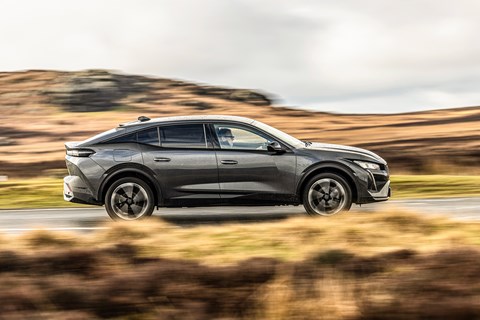
A quick look behind the driver reveals a cavernous back seat with legroom to spare, and a huge boot (choose the PHEV, and the hybrid battery pack raises the floor, reducing boot height). There’s nothing clever about the rear seats – they fold conventionally 60:40, and nor do they slide or recline. Headroom is fine for six-foot me, but tight for anyone taller. I arrive in a relaxed frame of mind to find the Huntsman Inn full of Sunday diners, enjoying roasts and red wine.
Next day, fog clings to the moorland. I edge gingerly through the mist to our meeting point, near Holme Moss summit, 1719ft high, the border of West Yorkshire and Derbyshire, and home of the highest transmission station in England.
Range, fuel economy and long-distance touring creds
Jake Groves turns up in the Formentor after his early start from Peterborough, 122 miles distant. Despite starting his PHEV journey with a full charge and using the built-in sat-nav to best manage the battery, he reports a disappointing fuel figure of 41.8mpg to Holme Moss. The non-hybrid Peugeot is averaging better (41.3). By the end of the day, the Cupra’s mpg has dipped to 36.3. (Officially, the e-Hybrid 245 Formentor is supposed to average 176.6-188.3mpg, once again showing how nonsensical PHEV official fuel figures are – unless you do short journeys and always start with a full charge. Real-world electric-only range is about 25 miles: officially it’s 34.)
Martin Fitz-Gibbons has drawn the short straw: he’s in the pure-electric Kia. Now, as we shall see, there’s not much wrong with the EV6. But there’s plenty wrong with an early rendezvous that involves long distances and an electric car.
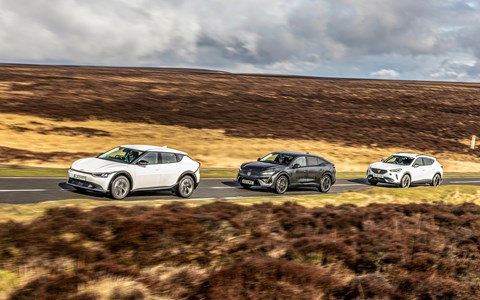
He has to stop and charge, but fortunately the InstaVolt charging station in Sheffield is working fine and after 34.36kWh is delivered in 44 minutes (cost: £25.77), Martin is on his merry way. Mind you, the claimed 120kW charger is delivering its juice at well under half its potential. Why do EV public charging stations so frequently disappoint? And, of course, if Martin had been in the 408 he would have been in and out with a full tank (and almost 500 miles of range) in five minutes. You do sometimes wonder which is the new tech…
I’ll be honest, at this stage of our Giant Test and its Battle of the Powertrains I am prepared to give premature victory to the good old-fashioned combustion contender; fast to refuel and better mpg than the PHEV.
We climb down off that Pennine peak and the fog clears. The Peak District opens up into sun-kissed gentle folding hills of tawny brown and wintry green hues. I swap into the Formentor. It is a pleasant change after the good but rather anodyne-driving Peugeot.
The Cupra feels like a sports hatch. Nice chunky perforated leather-rimmed steering wheel, low seating for an SUV, driving position just-so – including perfect alignment of steering wheel and pedals (the Kia’s are noticeably askew). Classy sporty cabin, a notch above the 408, although let’s not forget it’s a higher-spec model. Excellent thigh-hugging sports seats, and comfortable too. The best here. I like the copper trim highlights, a Cupra signature. Otherwise the trim is coal-hole VW Group black, and that’s fine by me.
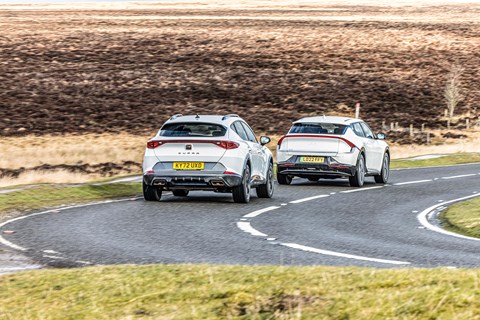
The Cupra brand may be new, but it feels like a properly mature product – as well it might, given the platform (shared with the Golf and Seat Ateca, among others) is several years old. Steering is reassuringly alert and body control is more composed than on the longer 408. The ride errs on the side of firm, which is great for sweeping over moorland roads. On such surfaces, the Cupra has the best, and most entertaining, chassis here. On the motorway, it’s better to go by 408. The Cupra’s ride jolts, even in its softest chassis setting.
Push the button at the bottom of the steering wheel and scroll through the powertrain and chassis settings. Normal is best for most uses, Cupra (the sportiest) too harsh for pockmarked UK B-roads. The engine growls menacingly in Cupra mode, as an artificial five-cylinder engine note is piped through the (four-cylinder car’s) speakers. It’s an entertaining drive for a 1.7-tonne SUV, by some margin the most enjoyable car of this bunch for winding and undulating Peak District roads.
There are two significant caveats. The PHEV powertrain cycles smoothly between petrol and electric modes when driven gently or around town. But push on and it becomes indecisive. This is a common PHEV malady in spirited driving, as the electronic brain tries to balance battery versus piston power. The upshot is a jerky drive and poor throttle response.
Much of the fun of driving evaporates if the powertrain does not precisely follow your throttle pedal commands. You feel detached from the driving experience. On the PHEV Formentor, the throttle pedal is not your driving friend.
PHEVs can also suffer from mushy brake feel, and in this area the Cupra isn’t bad. Pedal feel is firm, although more feel would still be welcome. There’s decent power, though. Use e-boost – floor it, and the e-motor gives you everything it’s got – and the acceleration is surprisingly brisk. It feels like more than 242bhp. So, if driving enjoyment is a priority, go for a non-hybrid Formentor, which also means a useful weight saving, and that boosts agility.

The other big frustration is all those buttons on the steering wheel. Steering wheels are for steering – not for reconfiguring the dash, answering the phone or for firming the dampers. McLaren is one of the few car makers to understand this. Anyway, the Formentor is especially bad, with a steering-wheel button arrangement that baffles this old motoring journalist and equally baffles young Jake Groves. Unambitious tasks, like switching on the speed limiter, can be a several-step process, notes Jake. The infotainment is less intuitive than the 408’s and takes some practice. Elsewhere in the cabin, we find good rear seat and boot space, although it’s less commodious than the longer 408 (or the EV6).
I was looking forward to driving an EV6 again. I last drove one in the summer of ’22. The EV6 GT-Line S was one of the best cars I drove all year and, along with the spectacularly styled Audi e-Tron GT, the best EV. I prefer the cheaper Air RWD version, as tested: its handling balance is sweeter than the all-wheel-drive GT-Line, it’s a little lighter, and it’s better value. Its lower power output (single e-motor, not dual motor) is neither here nor there, and there is a modest boost to its range.
It’s a fine-looking car, at least to my eyes. Cleanly styled (unlike the 408), ultra-modern, head turning: a new breed of car, and it looks it. It is of course a bespoke EV (Kia’s first), without all the compromises that plague EVs that start life as combustion cars. (Such as the Niro EV and Soul EV, and the upcoming e-408.)
It’s easily the most spacious inside and has the highest quality interior. The seats are handsome, comfortable and slightly spongy. The cabin is classy, seemingly minimalist (though in fact buzzing with gadgets) and practical – including a huge storage bin under the floating centre console. There are two curved 12.3-inch screens, for digital dials (in front of the driver) and the central infotainment touchscreen. Touch-sensitive toggles below the screen allow easy adjustment of heating, ventilation and audio.
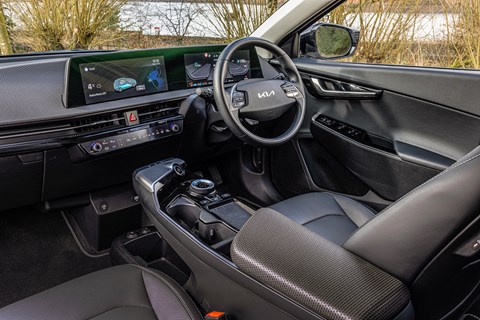
After the 408 and the Formentor, you step into the EV6 and feel you’ve stepped a decade forward.
It’s not as communicative as the Formentor on the snaking Peak District roads, and you don’t buy an EV6 for driving fun. The steering – by a rather retro padded oval-rimmed wheel – doesn’t talk to you like the Cupra’s, and it’s not as pointy as the 408’s. It steers without feel but does so smoothly and predictably.
The chassis doesn’t telegraph the road’s bumps and yumps as richly as the communicative Cupra, but nor does it float like the softly sprung 408. Rather, it smothers bumps with its bulk (like all EVs, the Kia is heavy at a smidgen under two tonnes), its chassis competence and its rather balloon-like tyres. It’s more like an express train than a plaything as it silently charges over the moors. It also feels – like most new-breed EVs – pretty damn fast. It accelerates smoothly and briskly, with distinctive jet-engine-like whine, and it just keeps charging as the e-motor spins ever higher. Select Sport mode, and it gets keener and more hyperactive. Normal mode is, however, just fine.
The EV6 is sharper and sportier than the sister Hyundai Ioniq 5 – but it’s hardly a sporting car. Rather, it’s quiet, comfortable, fast and relaxed as it powers over the roof of England. Okay, it could be more fun, but there really isn’t much not to like.
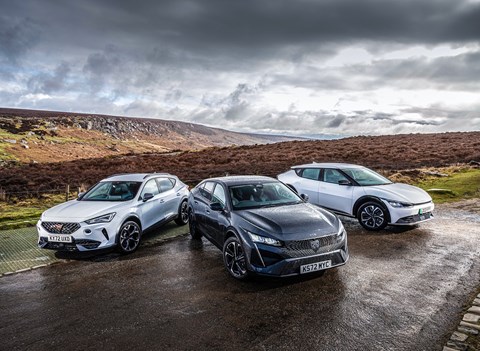
The decision to award last place was much tougher than deciding a winner. To be frank, neither the Cupra nor the Peugeot deserves the wooden spoon. They’re both good cars, and both have their appeal.
If you want a car to ply the motorway, city to city, the 408 is the best car here. It’s more composed and relaxing than the firmer-riding Formentor. And its quick splash-and-dash petrol refuelling gives it a clear practicality advantage over the Kia (although the EV6 is even quieter and more refined, and by slow-refuelling EV standards it can charge lightning fast).
On the other hand, the Cupra is the sportiest car here. It has the best chassis, seats and steering, especially noticeable on the Peak District’s challenging roads. Its PHEV powertrain also delivers decent punch. Alas, its jerkiness and iffy throttle response relegate it down our rankings. Its DSG gearbox – more efficient than an auto, but often jumpier – probably doesn’t help. For driving enjoyment, we’d suggest a non-PHEV Formentor.
So the Peugeot narrowly takes silver from the Cupra. It’s an eye-catching car, spacious and comfortable. Its SUV/crossover genes may – finally – persuade British buyers to love a big Peugeot again. It’s also pleasant to drive, has a nice interior, and is reasonably agile for a big car. Its overall fuel economy on test was also better than the hybrid Cupra’s – no real surprise to us on a test of well over 400 miles, but certainly contrary to the green gospel.
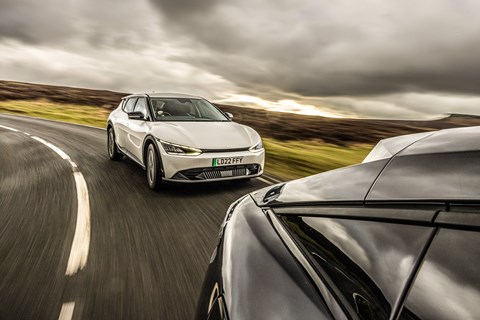
The Kia is a class apart. It’s the most strikingly styled, has the most spacious and comfortable interior, and the best cabin design and furnishings. It’s fast and has much more pleasing throttle response than the PHEV Cupra: smooth, instant torque and rapid.
Like all EVs it’s too weighed down by its batteries to offer the agility necessary for truly responsive driving. Yet it’s still very satisfying to drive. It’s beautifully composed, even on challenging roads. It’s eerily quiet, the smooth and silent mile eater. Its speedy silence brings a smile. Floor it, especially from low speed, and your smile will get even broader.
It’s also one of the world’s best EVs, another sign that – of all the oily car makers – it is the Koreans who best challenge dominant Tesla. Its realistic 300-mile range appeals, its fast charging another bonus. It also feels like you’re driving the future, not the past. And there’s something very satisfying about that.
More comparison tests by CAR magazine